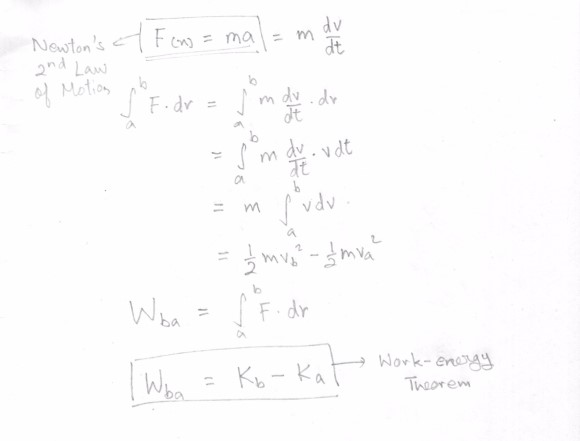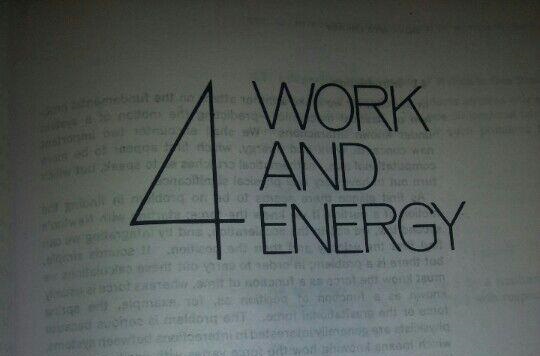What will happen if we integrate the Newton’s second law of motion?
I’m studying deeply about Work and Energy these days. I realized yet again just how connected physics is from the beginning to the very end. How physics let us solve huge-huge derivations with tiny little concepts. Isn’t that amazing? Maybe it’s the very undeniable reason why I am so much into physics.
This chapter (Work and Energy) in the college-physics mostly deals with the ‘work-energy theorem. Though I know that it’s a small chapter to deal with, its core concept could be simply understood just by differentiating the Newton’s Second law of motion.
According to the text books that we studied at high school, ‘the work-energy theorem’ states that the Work produced by a net force working on an object is equivalent to the difference in kinetic energy produced by the object; [W=K’-K].
Let’s take a deeper look into at the terms and expressions used in this theorem.
The work (W ) is defined to be done whenever a force acts on a body and it moves a distance in the direction of the force; [W=F•s]. Easily speaking, the work (W ) is a result of an applied force (theoretically an applied force would end up moving the object into its direction).
An Energy(E) signifies the capacity or ability to do work; an ability here means the amount of work an object can do. So, it can be easily said that energy is the cause-capacity of work.
In the world of mechanics, there exists two kinds of energies; Kinetic Energy (K) and the Potential Energy(U). The sum of these two energies is known as Mechanical Energy; [M.K. =K+U].
The ‘Work-Energy Theorem’ has been highlighted for its great importance as its single equation functioned as a bridge that connects the work(W ) and the Kinetic Energy(K).The bridge that connects the result of force and its cause-capacity! The very reason of this chapter’s name, ‘work and energy’, is most probably because of the connection between the two elements that they wanted to highlight in this chapter! The students who studied science must be already familiar with the terms and expressions used in this theorem but I strongly emphasize them to have a second look at these terms before we go on further.
Let us now come back to the very question we asked in the beginning and write down the equation of second law of motion; [F=ma].
{In here, the acceleration(a) can be written as derivative of velocity(v); [dv/dt].}
Any students who studied mathematics would first think of shifting the notation(dt) to the force (F)’s side and then integrating it when this equation is given to integrate. If you have thought about the same, then you thought wrong. You have missed the very small but an important concept. That is: the force(F) isn’t the function of time(t) but a function that is defined by the change in distance(x); [F(x) =ma]. Therefore when we integrate the above equation, we have to change the notation(dt) into (dx) by using the equation of velocity, [v=s/t], before integrating it. If you have not taken this fact into to the consideration, then you have just made big mistake by completely ignoring the definition of ‘force’.
{Kinetic Energy is equivalent to half the product of mass and square of velocity of the object; K=½mv²}
If you have done the calculations right, then you would have the result that says the integral of force(F) with respect to distance,[∫ Fdx], is equal to the difference in kinetic energies(K’-K). Look carefully. The integral of the force with respect to the distance(∫Fdx) is equal to the definition of the ‘Work (W )’. Thus, we finally prove the ‘work-energy theorem’, we praised of, which says Work (W ) is equivalent to change in kinetic energies (K’-K).
But there is one last thing that we need to look at before we get over with this topic. That is the situation where we equated the integral of force [∫Fdx], with respect to distance, to be equal to the Work done (W ). In this equation, clearly the integration is dependent on the path the object follows. But in real life, it is hard to find the ‘work’ that has predetermined ‘path’. Think about a situation where you need to find a path an object follows even before a force is applied to it and haven’t even moved! It is almost impossible to do that!
Say this equation has been integrated, then it would mean that the path and the motion of the object would have been predetermined even before the known force was applied. This only possible with the following conditions:
- Force has been conserved (integration becomes possible if we just know the terminal points if the force is conserved.)
- Force has been constrained (motion in here is constrained; there is change is direction but no work is done e.i. roller coaster and pendulum)
Yes, the ‘Work-Energy theorem’ a mathematically derived result of Newton’s second law of motion. A theory that is this mathematical cannot be applied in the real life easily.
If I was a physicist who had to research about work and energy of an object, I would first check whether the force is conserved/constrained or not. Because only after that, I would be able to know whether work and energy have their relation or not.
At this point, to supplement our research, there comes the one of the most fundamental theory in physics, the ‘law conservation of energy’, into the picture. I will upload a separate post about this next time whenever I get a chance…

Ans.: Work-Energy Theorem…


A nice effort and simple to understand. Keep up the good work. CHEERS!
LikeLiked by 1 person